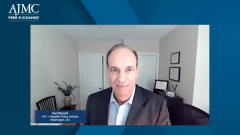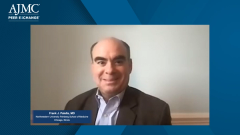
USPSTF Guidelines for HIV PrEP: Coverage for Drugs vs Ancillary Services
Carl Schmid and Frank J. Palella, MD, discuss how coverage differs for medications vs ancillary service costs for HIV PrEP based on USPSTF guidelines.
Episodes in this series

Ryan Haumschild, PharmD, MS, MBA: I’m going to shift the question that I have back over to Carl. Carl, from your perspective and your role, how does coverage differ for medications vs some of these ancillary service costs, such as HIV testing, looking at renal function, pregnancy screening, adherence counseling? Are those being covered? Do you still see disparities in care regarding the coverage of those agents outside of just the drug themselves? Give us a little more context around that.
Carl Schmid: The answer is they both need to be covered without cost-sharing. We’re seeing issues by payers. This is the responsibility, unfortunately, of the patient [who] must complain and fight. I get calls quite frequently saying I’m still being charged. I got a bill for $200 for my labs. This is a barrier. And we need to call insurers out. We need to file complaints with insurance commissioners and let the Department of Health and Human Services know about this, but we need enforcement. But to be clear on what is covered and what’s not, it’s in the FAQ that HHS [Health and Human Services] put out, but also what they refer to is the CDC [Centers for Disease Control and Prevention] guidelines. The US Preventive Services Task Force also refers to the CDC guidelines and they do change. We just saw one come out recently and they changed the frequency of certain tests. That’s what the payers have to follow because that’s what the guidance says, and the US Preventive Services Task Force says as well but refer back to the CDC guidelines. That’s what I encourage providers and payers and patients to follow.
Ryan Haumschild, PharmD, MS, MBA: Those guidelines are helpful because they provide clarity but it’s hard to make sure to see how everyone operationalizes it. That’s the key that we’re trying to see and there’s pain points with that operation. Sometimes from a health care facility when we’re trying to develop guidelines and pathways internally to drive utilization or as we leverage our electronic medical record to drive consistent use of screening and prescribing of agents, it becomes more difficult when you have payer-specific differences because you might have to be doing appeal for every single patient that we want to use this therapy on and others. It goes through and it kind of creates a burden on the workforce and also creates that gap of time to treatment that we know is so essential. Because if I have Frank, and he’s my provider and I’m seeing him, and there’s some time gaps there, that could also lead to lack of adherence or lack of follow-up, which we know is essential.
Carl Schmid: You’re right, Ryan. How is a patient going to know what is in the CDC guidelines? It shouldn’t be up to them to fight all these things. Providers must do it for them. We need to lift those barriers.
Frank J. Palella, MD: If I may add just one other comment, in terms of CDC guidance, it’s been clear for more than several years, and I’m happy to see the newest incarnation of the CDC guidelines that the periodicity of follow-up matters hugely, not just in terms of PrEP, but this is an approach to STD [sexually transmitted disease] health. The difference between monitoring every 3 months versus every 6 months is a difference in being able to capture up to a third of gonorrhea, chlamydia, and syphilis cases. That’s huge from a public health perspective and from that individual’s perspective. The monitoring for PrEP is largely driven by the need for monitoring even more communicable STDs that often arise from sexual activities that are equally likely to transmit these other STDs as HIV. We really need to understand that underpinning. When I speak to payers and the justification for our practices as most recently outlined by CDC, it’s that prevention is always going to be cheaper than treatment. Certainly, that’s true for HIV. It’s true for syphilis. It’s true for gonorrhea. It’s true for many of the things that we do.
Ryan Haumschild, PharmD, MS, MBA: I love you kind of highlighting some of those. I don’t want to call them frustrations, but maybe I call them frustrations still and seeing how these are executed upon the guidance and I agree with you. Looking at it from a social responsibility perspective, which is what part of our role is but also explaining the value in a total cost of care, that if we don’t get ahead of this early on the cost continue to increase. That’s an important thing, not only just from a public health perspective, but even from a covered life perspective of getting ahead of it and being proactive. I appreciate you calling that out.
Transcript Edited for Clarity
Newsletter
Stay ahead of policy, cost, and value—subscribe to AJMC for expert insights at the intersection of clinical care and health economics.






























































